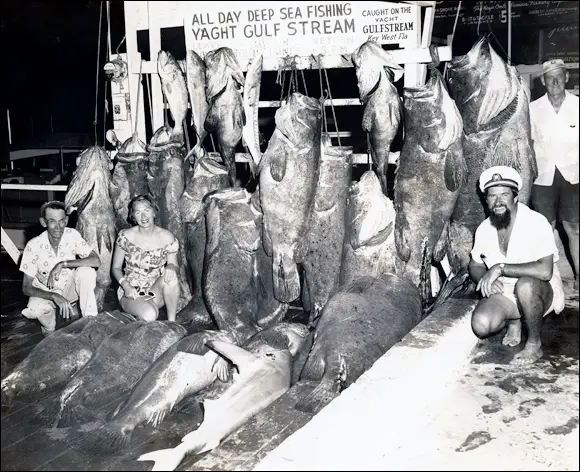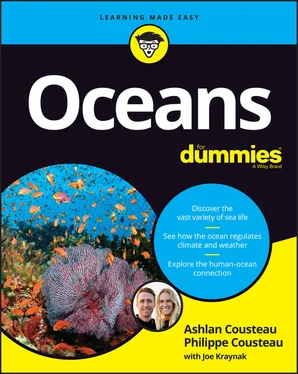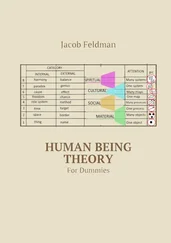No major event signified the end of the Oligocene epoch; it’s marked by small changes in fossils of algae and foraminifera (microscopic marine organisms). Nice to not have a mass extinction for a change, right?
The Neogene period (from 23 to 2.6 million years ago) is divided into the Miocene and Pliocene epochs, but don’t worry we’re not going to slice and dice this period. Here are some of the highlights:
Desmostylia (that crazy sea rhino thing) goes extinct.
Kelp makes its debut by forming its own kelp forests.
Aquatic sloths and sea otters appear.
Cetaceans (whales and dolphins) become more diverse in correlation with the increase of giant marine predators such as megatooth sharks and predatory sperm whales.
The continents are pretty much where they are today. North and South America are connected with a land bridge, enabling the Great American Biotic Interchange — when species moved freely between the two continents (open borders anyone?).
Plant and animal species begin to take on a more modern appearance, and most modern bird groups are established.
The first apes evolve from old world monkeys.
Early human ancestors, such as Australopithecus, introduce themselves and demonstrate their ability to create and use stone tools (Stone axes? Awesome).
The megalodon arrives. (We’re not afraid of sharks, but we wouldn’t want to swim with a megalodon even if we were holding a stone axe.)
Our human ancestors from the genus Homo arrive.
This period ends with the beginning of an ice age — a very long cold spell characterized by the expansion of continental and polar ice sheets and alpine glaciers.
The Quaternary period (from 2.6 million years ago to now) is divided into the Pleistocene and the Holocene epochs, and this time, we’re going to honor that division. (Note that some people believe the Quaternary epoch should be part of the Neogene period, but we’re going to keep it separate.)
The Pleistocene epoch ushered in some of the most awesome megafauna (large animals), including mammoths, mastodons, saber-toothed cats, giant sloths (they would have been so cute and s-o-o-o s-l-o-w), Megalania (a lizard you wouldn’t want to cross paths with), elephant birds, dire wolves (yes, Game of Thrones! ), cave bears, wooly rhinoceros, and aurochs (wild ox), but most went extinct during the transition to the Holocene epoch. And we also lost megalodons (so, no worries about bumping into an 82-foot-long shark).
Neanderthals evolved during the Pleistocene epoch, alongside more anatomically-modern human ancestors. The oldest living things today are two nematodes (wormy looking creatures) from the Pleistocene, who were frozen in ice 42,000 years ago, and were brought back to life, which is creepy and super cool at the same time. And human ancestors became Homo sapiens (let’s hear it for the humans!). During the Holocene, favorable environmental conditions allowed loads of species to grow and flourish around the globe. The Holocene also marks the beginning of agriculture.
And that pretty much wraps up 3.8 billion years of evolution, not that it has stopped or anything like that.
Taking the Earth’s Present Evolutionary Pulse
The evolution of life on Earth reveals three key takeaways: First, life as we know it is doomed. One of these days, BOOM!, massive extinction. Guaranteed. We don’t know how or when, but it’s gonna happen. Second, the living Earth is very resilient. Barring some cataclysmic cosmic event, such as the sun expanding and gobbling up the planet, life will rebound after the next mass extinction. It may not look anything like life on the planet now, and humans may not make the cut, but that’s life! Third, we’re living in the midst of a wonderful epoch with a very impressive diversification of species — from microscopic bacteria to coral reefs to the blue whale, from algae to redwoods, from mice to elephants. The air, land, and sea are teeming with life.
Unfortunately, we (the people) are ruining it for ourselves, and we (the authors) aren’t going to sugarcoat it. Many scientists suspect we’re already entering the sixth mass extinction event on our planet (the five previous ones were mentioned earlier in the section “ Tracing the Evolution of Ocean Life”). But this mass extinction, called the Holocene or Anthropocene Extinction, is different from the others, in that no sudden and dramatic natural disaster, like a meteor the size of Manhattan slamming into Earth or a massive volcanic eruption, is responsible. Neither is it being caused by some millennia-long change in the atmosphere. No, this mass extinction is being brought on at a rate unseen in Earth’s history, and it is entirely our fault.
According to “The Living Planet Report” published by the World Wildlife Fund (WWF) in 2018, humanity is responsible for at least a 60 percent decline in the population size of all mammals, birds, fish, amphibians, and reptiles since 1970. Wildlife populations in rivers and lakes have declined by 83 percent due to destructive agriculture and dams. And it’s estimated that we have lost 50 percent of the total biodiversity on Earth, all in the last 40 years.
As if that’s not bad enough, scientists estimate that the average baseline (historical) rate of extinction is one species per one million per year, not counting species lost due to human activities. When you factor in extinctions that can be blamed on humans, that number is hundreds to thousands of times higher. In other words, the world loses thousands of species every single year thanks to us !
Stats and reports are easy to gloss over. What drives the point home is personal observation. For example, there was a time when the fishing in the Florida Keys was legendary, with people flocking to the water to haul in a big fish and pose for a photo. While they still do it today, it was long known that the size and diversity of fish was declining dramatically, but it wasn’t until 2007 when an intrepid graduate student named Loren McClenachan found an ingenious way to calculate how precipitous that decline actually was. While visiting a local library, Loren discovered a collection of historical photos documenting sportfishing catches over 60 years from the same area. She realized rather quickly that she had discovered something significant. Using a time sequence of dozens and dozens of photos, three of which are here (see Figures 3-6, 3-7, and 3-8), Loren was able to calculate the change in size by measuring over 1,200 fish in the historical pictures. McClenachan concluded that the average fish caught in the 1950s were over 6 feet long, while in 2007, the largest fish were about 1 foot long. That is an 88 percent drop in catch size! Her research was published in the scientific paper: McClenachan, L. 2009, “Documenting loss of large trophy fish from the Florida Keys with historical photographs,” Conservation Biology 23:636-643.
What recreational fisherman were happy to catch in 2007 would have been laughed at by the fisherman in the 1950s as bait. This is known as shifting baselines (see the nearby sidebar for more). People don’t know what they’re missing out on because their perspective doesn’t benefit from historical knowledge. The good news is that aggressive conservation efforts have seen some fish stocks begin to recover over the last few years, but a tremendous amount of work is still needed.

Source: Monroe County Public Library. Photo by Wil-Art Studio. Licensed under CC BY 2.0
Читать дальше













